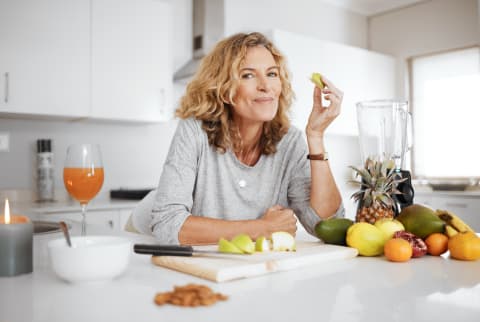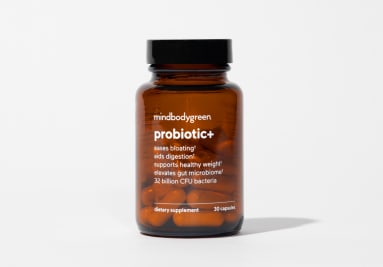
Image by PeopleImages / iStock
June 17, 2023
Our editors have independently chosen the products listed on this page. If you purchase something mentioned in this article, we may
What do you reach for when you feel particularly peckish? Maybe it’s a bowl of popcorn, chips, candy, or something else you can easily snag from the pantry. Of course, processed snacks aren’t horrible every now and then (sweets are good for the soul!), but you might not want to make those nibbles an everyday habit.
But it can be oh-so difficult to kick those crunchy, salty, and/or sweet cravings! How can you train your mind to seek out something healthier? According to integrative medicine doctor Amy Shah, M.D., author of I’m So Effing Hungry, it all begins with gut health.
Advertisement
This ad is displayed using third party content and we do not control its accessibility features.
How your gut controls cravings
“The gut is a stronger driver of cravings than even our minds,” Shah says on the mindbodygreen podcast. “Most of your cravings are coming from the gut bacteria1 that are fighting for the messaging to your brain.”
Essentially, your gut bacteria send certain signals to your brain to crave certain foods. “Gut bacteria want to survive, and they’re able to actually hijack the communication systems in our bodies to satisfy their own hunger and cravings,” Shah explains.
She even references a study on germ-free mice (meaning, free of all microorganisms), in which researchers gave the animals different compositions of gut microbes—later on, the mice voluntarily changed their diet preferences. “The taste preferences completely changed to what the gut bacteria wanted,” Shah explains, which demonstrates just how powerful your gut can be when it comes to choosing what you want to eat.
How to feed your gut
The question becomes: How do you encourage your gut bacteria to crave healthy foods? Well, according to Shah, you fuel them with the nutrients they need to thrive.
Advertisement
This ad is displayed using third party content and we do not control its accessibility features.
“One of the biggest things that we’ve seen in a landmark study recently is that fermented foods make the biggest difference in the gut microbiome,” says Shah. (Specifically, the study found a high-fermented foods diet increased microbial diversity and lowered 19 inflammatory markers2.)
Think foods like yogurt, apple cider vinegar, kefir, kimchi, kombucha, and miso. These fermented staples are created through fermentation (duh), in which components of foods, like the natural sugars, are broken down by yeast and bacteria and result in food chock-full of probiotics (aka, the good bugs). And “adding more actual bacteria-laden foods into your diet is a way of improving gut health,” says Shah.
If you’d like to add even more beneficial bugs to your gut, you might consider taking a probiotic, too. After all, it can be difficult to eat enough fermented foods every single day; whereas taking a daily supplement is a relatively low-lift venture to add to your morning routine.
What’s more, a targeted probiotic can be helpful for any specific digestive needs (think bloating, gas, regularity). For instance, one study suggests that a combination of Lactobacillus 3and 3Bifidobacteria 3can ease bloating3.
Researchers also found that women who took a certain strain of probiotics for 12 weeks had higher leptin levels (which is a hormone that suppresses appetite) compared to the group who didn’t take a probiotic. As a result, the women lost more weight4.
Curious about these specific strains? Here, you can find our list of the best probiotic supplements on the market.
Advertisement
This ad is displayed using third party content and we do not control its accessibility features.
Finally, “Gut bacteria love fiber foods,” says Shah.
Fiber is a type of complex carbohydrate found exclusively in plants that isn’t broken down in the digestive tract and, therefore, helps with satiety, digestion, blood sugar balance, healthy bowel movements, and microbial balance (i.e., good versus bad gut bugs).
You can seek out fiber-rich staples, like buckwheat, barley, kale, broccoli, lentils, and more—or Shah says to keep it simple just by eating real, whole foods. “Ultra-processed foods are devoid of fiber,” she notes. “So you want to eat real foods that don’t have labels on them. Fruits, vegetables, [and] whole grains.”
The takeaway
Look, sometimes cravings happen—and that’s OK! Don’t beat yourself up for indulging every now and then, but according to Shah, maintaining optimal gut health can help encourage healthier cravings for the long haul. “When we nourish the gut,” she says, “we can actually change our cravings so that they can help us make better decisions, feel happier, and be healthier overall.”


